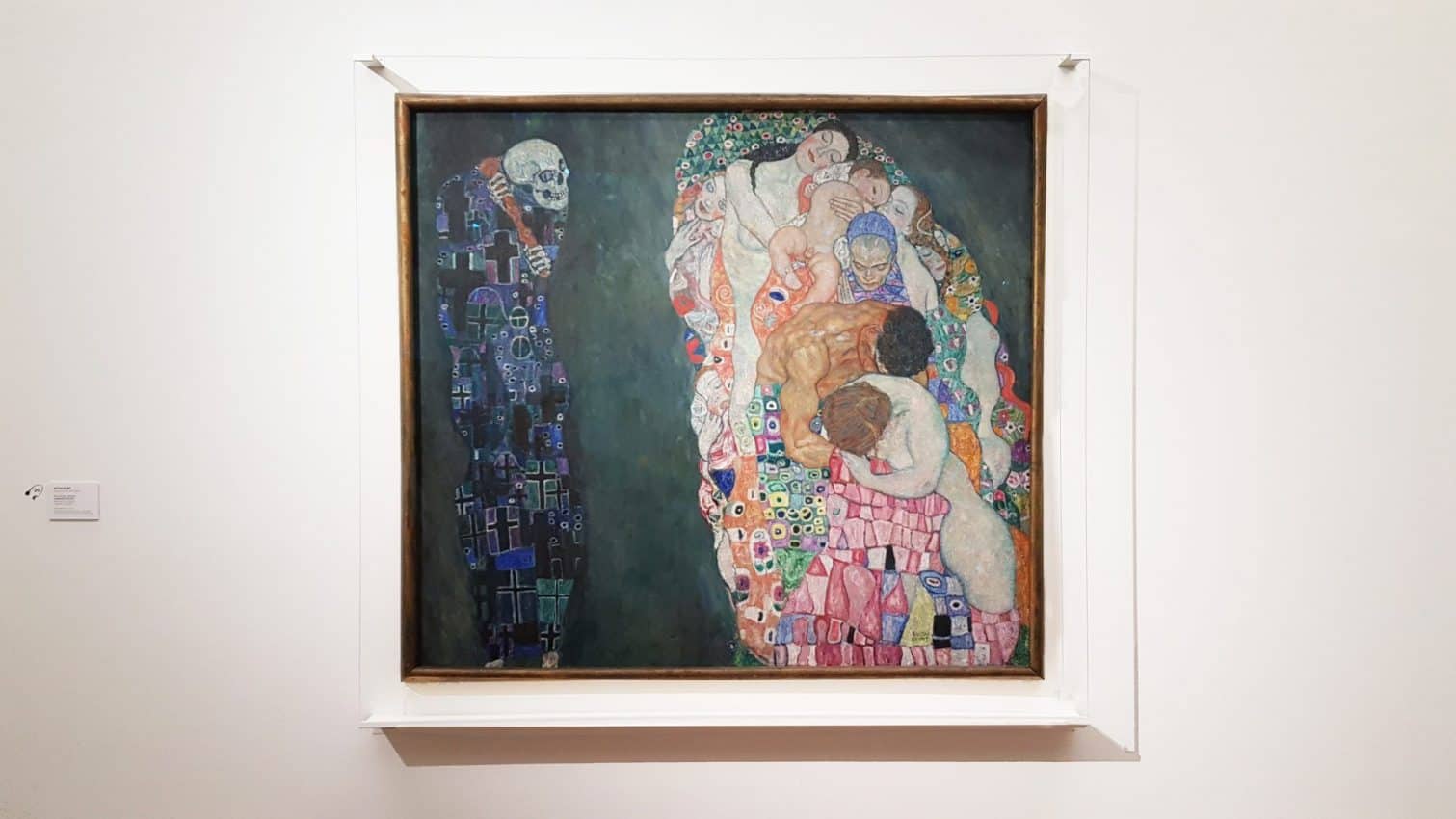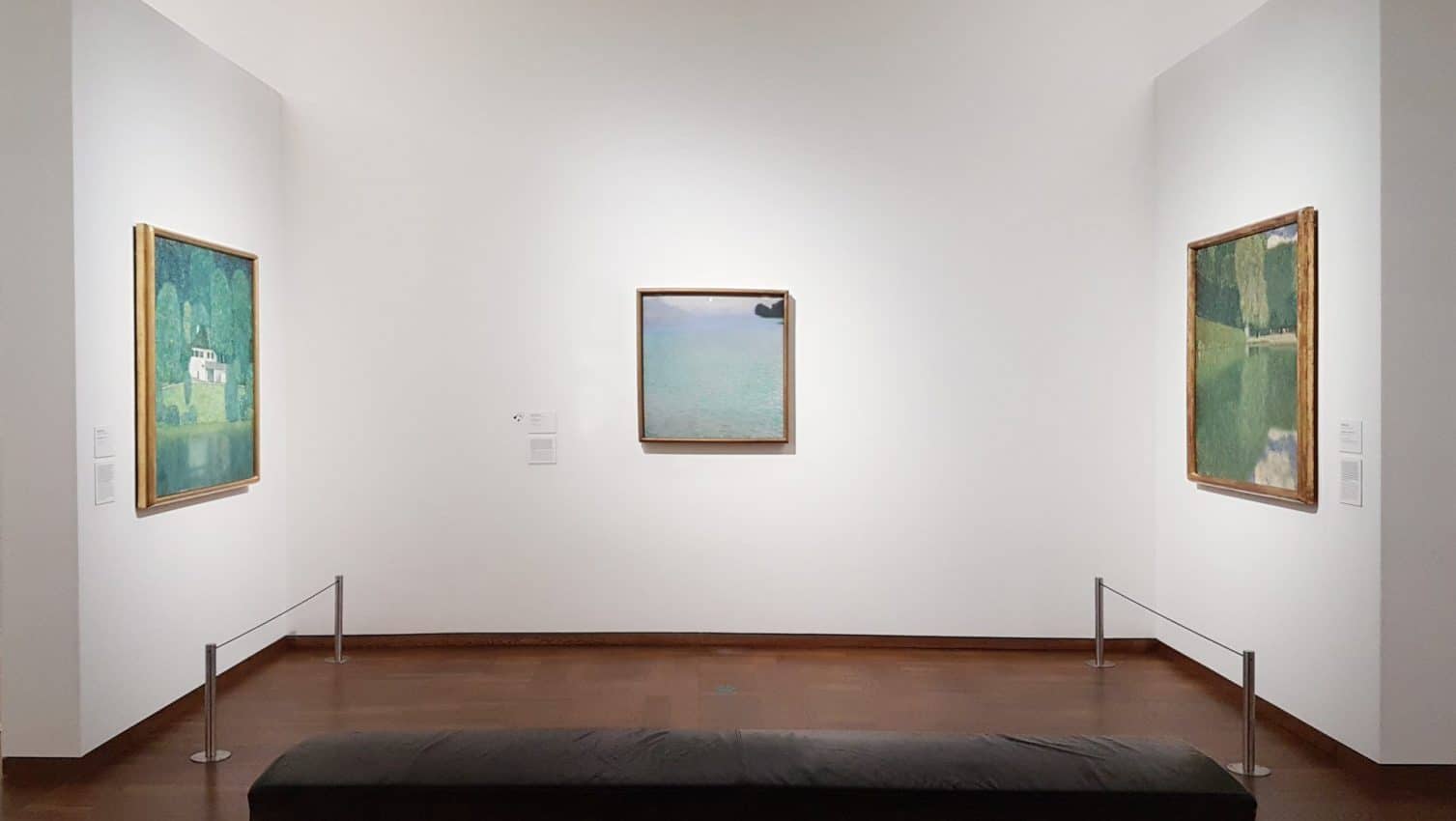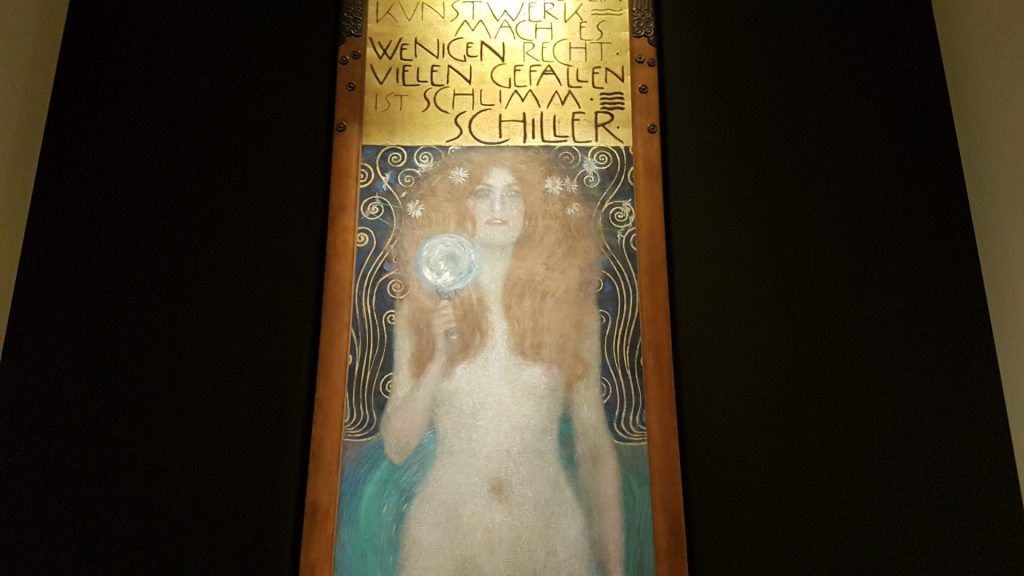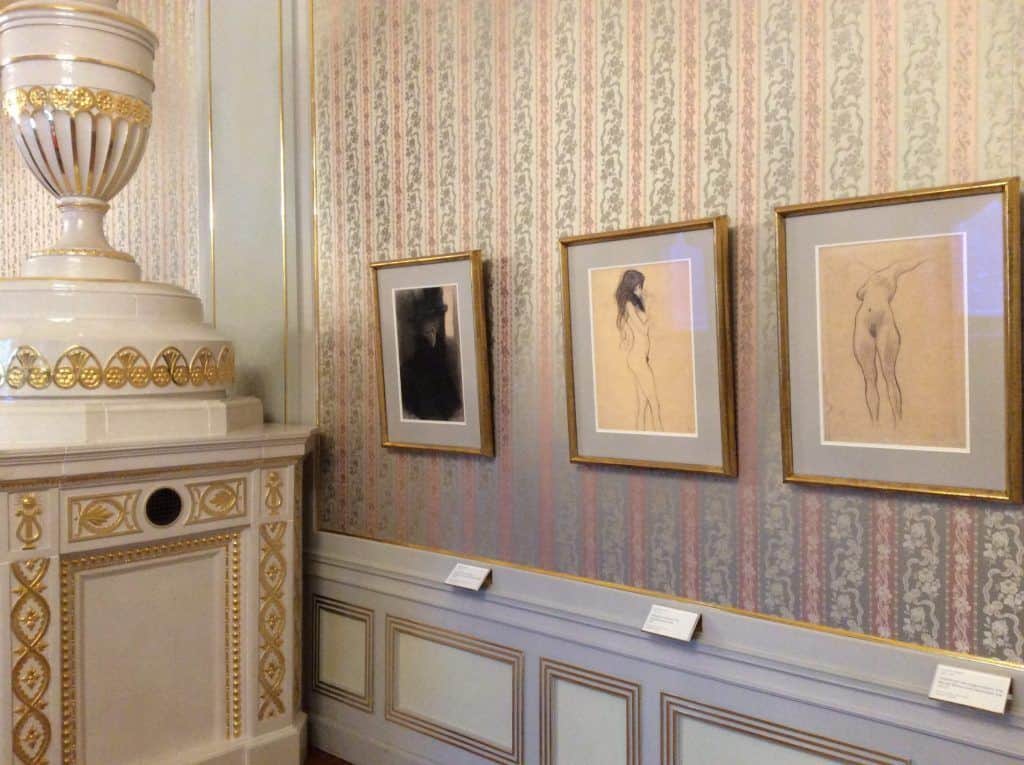All this Klimt! A Guide to Gustav Klimt’s Works in Vienna
where you find all his paintings
Gustav Klimt and his painting are one of the reasons why millions of tourists visit the Austrian capital every year. For good or bad, there isn’t just one “Klimt Museum” in Vienna, and to see the “right” Klimt, you have to go to the right museum, or even several. Because the artist was born and died in Vienna, you can spend days walking from one museum to another to see if not everything, then the most important things. If that’s what you’re planning to do, this list may come in useful.
1. The Upper Belvedere / Schloss Belvedere
It is the Belvedere Palace where the famous Judith and The Kiss are displayed. The same collection used to have the Portrait of Adele Bloch-Bauer I. But since 2006 you will find this masterpiece in the Neue Galerie New York, where the heiress of the Bloch-Bauer family, Maria Altmann, sold it for a record price of $135 million. Now, you can only see three famous “golden” paintings together on the umbrellas in the souvenir shops.






Fortunately for visitors to the Belvedere, there is still another “Lady in Gold” at the Belvedere, who bears some of the facial features of Adele Bloch-Bauer. Recently, however, some experts have come out in favour of art historian Marian Bisanz-Prakken’s version that the model was not Adele Bloch-Bauer but the opera diva Anna von Mildenburg. The question of whether Holofernes bears some resemblance to Gustav Klimt himself is also open to debate. Whatever the case, this depiction of the Old Testament heroine Judith is a bold display of unabashed female sexuality in art and is certainly one of the jewels of the Belvedere collection.
There are a total of 30 paintings in the Belvedere Art Gallery (not counting the Beethoven Frieze, see Secession below), but you can’t see them all in one visit. The museum is highly active in exhibitions, so between a third and a half of the works are either on view in the Lower Belvedere and other Viennese museums or on an international tour. You can always check how many of Klimt’s works are currently on display in a special database on the museum’s website.
The Kiss, but not only
The Kiss is the main tourist attraction of the Belvedere, and it’s impossible to miss it since all the museum signs point towards the celebrated piece. This is the only painting in the collection that is exempt from touring. Keep in mind that a large crowd of admirers and instagrammers always gathers around this Klimt work, so to enjoy the painting in relative peace, it’s best to come right at the museum opening time. However, this renown double portrait isn’t the only reason to visit the Belvedere. Famous portraits of society ladies, such as Fritza Riedler or Sonja Knips, can also be found here, as well as meditative Attersee landscapes. Also Klimt’s unfinished canvases The Bride and Adam and Eve that were left behind when he was taken to a hospital are in the collection of this museum. Moreover the Belvedere often exhibits pieces from Viennese private collections.


But not only the collection of the most celebrated works by Klimt is of great interest here. Undoubtedly the context of national art history is an important aspect of viewing Klimt in this museum. Although the new exposition (opened in 2023) has few academic works, it’s still a good place to get an idea of Klimt’s immediate predecessors and contemporaries.
Address: Prinz Eugen-Straße 27, 1030 Wien
Opening hours: daily 9:00-18:00
Official website of the Belvedere Gallery
2. The Leopold Museum
Death and Life is the most precious piece by Klimt in the collection of the Leopold Museum. The last piece of the “Golden Period” is surrounded by Klimt’s early realistic portraits, works by his brother Ernst, and several documents. Several landscape works demonstrating the artist’s experiments with painting techniques are also on display.






The Leopold Museum also reconstructed the scandalous Faculty Paintings from photographs. These lost paintings are shown in a separate room accompanied by the documents with devastating criticism by artist’s contemporaries. The context of Klimt’s works here is carefully created out of documents, reconstructions and works of his fellow artists. All of them were his contemporaries and many were also members of the Secession movement. All pieces on display depicting the cultural and social life have the specific air of that short and bright period of Fin de Siècle. Yet one more reason to see Klimt’s paintings against the backdrop of the masterpieces by Wagner, Loos, Moser, Schiele is that Klimt’s creative pursuits don’t look so exteptional as in the exposition in the Belvedere.
Address: Museumsplatz 1, 1070 Wien
Opening hours: daily, except Tuesday 10:00-18:00. Thursdays until 21:00
Official website of the the Leopold Museum
3. The Vienna Museum / Wien Museum
One more museum displaying diverse works by Klimt is the Vienna Museum. Admirers of Klimt come here to see the portrait of his muse, companion, friend, and lover, Emilie Flöge. The Vienna Museum also exhibits Pallas Athene, the symbol of Secession, and several portraits of the ladies whose names we no longer know thanks to which Klimt was first nicknamed “the painter of beautiful women”. These works can be found in the historical section of Art Nouveau era.






The collection also includes drawings and the portrait of Vienna society by Klimt that has a high historical value. Auditorium in the Old Palace Theater in Vienna is a way to preserve the architecture in eternity and a miniature portrait of every significant person in Vienna in 1888.
Address: 1040 Vienna, Karlsplatz 8
Opening hours: Tuesday to Friday, 09:00-18:00, Saturday and Sunday, 10:00-18:00. Free entrance.
Official website of the Vienna City Museum
4. The Vienna Secession / Wiener Secession
If you do not wish to compare different periods and would rather see “pure” Klimt, go to the Secession Exhibition Hall. This is where you will find the Beethoven Frieze, an in-situ piece that is displayed in the place it was originally made for. Even though the Secession Building was constructed by architect Joseph Maria Olbrich, it is known that Klimt took active part in designing it. I believe it is necessary to see the Beethoven Frieze under the famous phrase “To every age its art, to every art its freedom” to understand and to feel the idea and aesthetics of the “young art”.



In line with this motto, the main exhibition halls of the Secession Building are occupied by temporary exhibitions of contemporary artists, while Klimt’s pieces can be viewed in the basement. There is a room made especially for this piece after the World War II, so that works of the master would not take away a place designed for new artist.
I recommend to take an audio guide at the ticket counter to listen to the well-made commentary regarding the allegories present in the Frieze. However, if you prefer the language of music, put on the headphones provided in the hall free of charge to relish the Ode to Joy and instinctively guess the wall figures to look at.
Address: Friedrichstraße 12, 1010 Wien
Opening hours: daily, except Tuesday 10:00-18:00.
Official website of the Secession
5. The Theatre Museum / Theatermuseum
If you are ready to chase important Klimt’s works one by one, find some time to visit the Theatre museum. Nuda Veritas was bought by Hermann Bahr, a dramatist and critic, which is why today, this painting lives in Palais Lobkowitz of the Austrian Theatre Museum.


Nuda Veritas is a programmatic piece manifesting through Schiller’s words the unacceptability of the excessive popularity of good art. Nevertheless, it didn’t prevent Klimt from creating his most golden (in every sense) works after this manifesto.
Address: Lobkowitzpl. 2, 1010 Wien
Opening hours: daily, except Tuesday 10:00-18:00.
Official website of the Theatre Museum
6. Burgtheater
It is worth visiting Burgtheater if you wish to see the decorative pieses Klimt started his career with. This is the place to see the works he created soon after graduating from an art school, when he looked forward to receiving a good pay along with his brother Ernst and Franz von Matsch rather than starting an aesthetic revolution.



The young artists distinguished themselves when painting the interior so much that they even earned an honorary award from the emperor. Gustav Klimt painted four out of ten scenes embellishing the front doors. You will find the scene depicting the English drama especially interesting. In the painting, Queen Elizabeth is looking at the death of Romeo and Juliet, while Klimt and his companions themselves can be seen in the audience. This is the only self-portrait by Klimt (it’s hardly possible to recognize him in The Kiss or Judith, this is only a speculation of art historians) made for the purpose of self-promotion.
To see these paintings, come for the daily theater guided tour or a performance.
Address: Universitätsring 2, 1010 Wien
Guided tour tours take place on Thursdays and Fridays at 15:00 and on Saturdays, Sundays and public holidays at 11:00. The tours are exclusively in German, but texts in English, Japanese, Italian, etc. are available for those requesting them.
Official website of the Burgtheater
7. The Vienna Art History Museum / Kunsthistorisches Museum Wien
If you don’t want to go to the theatre for the sake of interior paintings, you can also find Klimt’s works in the interiors of the Museum of Fine Arts.



During anniversaries, the museum even sets up the scaffolds so that the admirers could climb higher and have a closer look at the paintings, which the artist couldn’t have anticipated. Nevertheless, you can make an effort and distinguish the works by Gustav and Ernst Klimt and their colleague Matsch while standing in the grand staircase. Even though the artists tried to maintain the same style, it’s easy to see which works deserve the most admiration.
Address: Maria-Theresien-Platz, 1010 Wien
Opening hours: daily, except Monday 10:00-18:00. Thursdays until 21:00
Official website of the Vienna Art History Museum
8. Museum of Applied Arts / Museum für angewandte Kunst
You will find the cartoons for the mosaic friezes of the Stoclet Palace in the permanent exposition of the Museum of Applied Arts. They blend in seamlessly with the furniture and chinaware of the Viennese artisans. The paper is covered with numerous work notes that always have the charm of an autograph.



The museum also displays Klimt’s Magic Garden, an installation, nearby. Wear augmented reality glasses to wander the smalt streets under silver bells around golden mushrooms. This is a truly addictive experience, and even though the artists were inspired by the cartoons, it is mostly meant for amusement rather than artistic expression.
Address: Stubenring 5, 1010 Wien
Opening hours: daily, except Monday 10:00-18:00. Tuesday until 21:00
Official website of the Museum of Applied Arts
9. Albertina
There are approximately 170 drawings in the Albertina collection, but like all graphic art, they are very fragile. This is why you can only find some high-quality facsimiles in the historical part of the Albertina, in the Spanish room. Bear in mind that the Albertina changes this display quite often and instead of Klimt you may find drawings by Dürer or Michelangelo, also in copy.
NB Currently you can find three original drawing by Klimt in the exhibition Michelangelo and Beyond (till January, 14 2024)



One of his Goldfishes is also exhibited together with Rodin and Monet in the “Monet to Picasso” exposition. It’s rather peculiar to see this painting surrounded by the French art that is recognized worldwide, while Klimt is still known as a national Art Nouveau representative despite being quite popular.
You can’t really appreciate the Albertina’s collection unless you attend one of the temporary exhibitions, such as the Albertina Modern’s anniversary exhibition.
Address: Albertinaplatz 1, 1010 Wien
Opening hours: daily 10:00-18:00, Wednesday and Friday till 21:00
Оfficial website of the Albertina
Reconstructions
In above listed places you will find all original works by Gustav Klimt, which can be found in Vienna’s public collections. A number of paintings (including Danaë), not to mention hundreds of drawings, are in private collections and only occasionally exhibited in museums. If you are fond of reconstructions, you might also like the Hermesvilla and Klimt Villa situated on the outskirts of the city.
Villa Hermes / Hermesvilla


Hermesvilla used to be the country house of the Habsburg family. Nowadays, it is used by the Vienna Museum. Among the luxurious interiors designed by various artists of great local significance, you can also find the restored and renewed ceiling painting The Spring by Klimt, his brother Ernst, and their colleague Franz Matsch.
Address: 1130 Wien, Lainzer Tiergarten
Opening hours: March 15, 20th to November 1, 2022: Tuesday to Sunday, 10 a.m. to 6 p.m.
Оfficial website of the Hermesvilla
The Klimt Villa
This purely marketing name now refers to the building on the site of Klimt’s last studio. In other words, Klimt did not see the building that you can visit today; he worked in another, much more modest house on this very site. But if your interest is not only in his art but also in his personality, this villa is a good place to try to imagine the kind of environment in which Klimt lived and worked.



Today’s owners have filled the villa not just with replica paintings and copies of documents. They have also tried to reproduce the interiors of the studio, using photographs by Klimt’s friend and colleague Moriz Nähr. The rooms, which are not occupied by reconstructions, are filled with information panels. Here you will find a catalogue of lost works, a description of the meeting with the Japanese artist Kijiro Ohta, and a newspaper chronicle of the process of handing over the portrait of Adele Bloch-Bauer to her heiress, Maria Altman.
All in all, the villa and the garden, in which “Klimtian” flowers are now planted, are beautiful and “memory of place”, however subtle, is here, and it is interesting in its own way. Don’t miss it if you go to Klimt’s grave, as it’s not far from the cemetery to the villa, and you’ll get to know a very pleasant part of Vienna at the same time.
Address: Feldmühlgasse 11, 1130 Wien
Opening hours: daily, except Monday 10:00-18:00
Official website of the Klimt Villa
Klimt’s grave
Klimt’s grave is also located in this thirteenth district. It is not far from Villa Klimt to the Hietzing Cemetery. The grave is easy to find, it is located on the left side of the cemetery (when looking from the entrance) in group 5 under the number 194. The tombstone’s laconic appearance gives away post-war work. Its author, Austrian sculptor Josef Schagerl junior, who worked on the restoration of many iconic heritage sites after the war, was probably well aware that working with heritage is not the most appropriate way to express oneself. The slanted plate bears only the Klimt’s name, his autograph. In 1962, when this monument was erected, it was already obvious that dates and epitaphs next to this name became superfluous.


Address: Friedhof Hietzing, Maxingstraße 15, 1130 Wien
Opening hours: November, February 8 a.m. to 5 p.m., March, October 7 a.m. to 6 p.m., April to September 7 a.m. to 7 p.m., and in summer the cemetery, like many Viennese museums, is open longer on Thursdays until 8 p.m.
Official website of the cemetery
All museums with Klimt’s works on the city map
Once you visit a couple of museums, you will realize that Klimt’s heritage is much more than just melancholic figures against the golden background. Even though his “golden” pieces became famous beyond control while Klimt was still alive, his admirers know that he created much more than just The Kiss, and his œuvre is way more diverse and worthy of your attention. Who knows, maybe it’s the peaceful landscapes or audacious Goldfish that will win your greatest favour.
I added these addresses to the map so that it’s easier for you to navigate the city. And I hope that once you have a look at it, you will agree that there is one museum devoted to Klimt in Austria, after all: its whole capital, Vienna.

You may also like:



